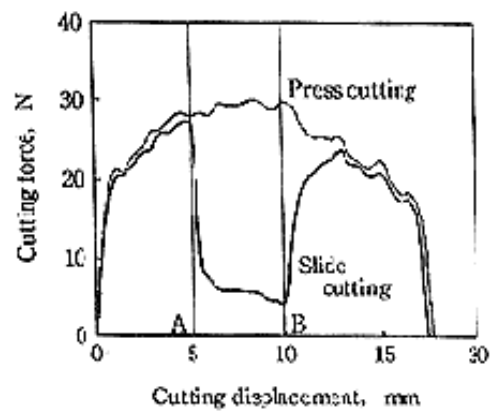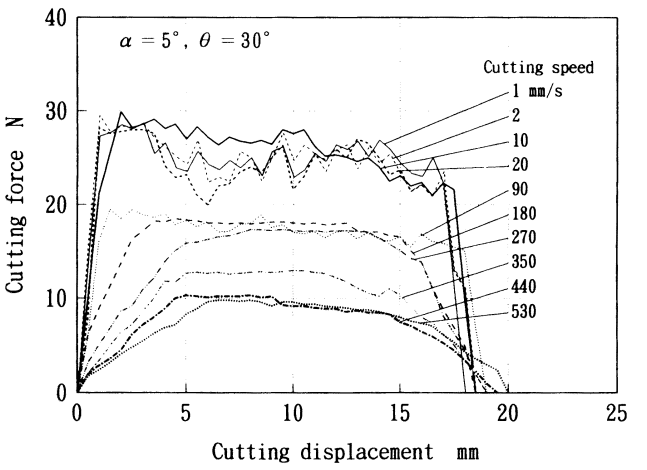Most people have used a blade to cut something at some point in their lives.
However, very few truly understand the physical principles behind how a blade actually cuts.
The same goes for the concept of sharpness.
We often say things like, “This kitchen knife cuts well,” or “These scissors don’t cut cleanly,” but few can explain why they perform that way.
Sharpness has traditionally been treated as a matter of personal feeling—something subjective and vague.
That is precisely why, in this article, we would like to explore the science behind sharpness, and examine what truly makes a Japanese sword so exceptional.
What Determines Sharpness? Exploring the Theory of Cutting
Two Ways to Cut an Object
When we talk about “cutting” something, there are fundamentally two different techniques: press cutting and slice cutting.
Press cutting is a straightforward method—simply pressing the blade down into the material.
In contrast, slice cutting involves first pressing the blade against the material, then sliding it horizontally while maintaining contact.
Anyone who has used a knife knows from experience that adding this slicing motion makes cutting much easier.

This graph shows the relationship between cutting force and distance when slicing a sample of sweet potato with a kitchen knife.
Compared to press cutting, the slicing motion (between points A and B in slice cutting) dramatically reduces the force needed to complete the cut.
While the exact amount of force reduction varies depending on the material, studies have shown that slice cutting requires only 1/10 to 1/20 of the force needed for press cutting.
The Relationship Between Cutting Speed and Cutting Force
Next, let’s look at the relationship between cutting speed and cutting force.
The conclusion may sound familiar: the faster you cut, the easier it becomes to cut through the material.

This graph shows the results of cutting tests performed at different cutting speeds.
As the speed increases, the required cutting force clearly decreases.
The reason for this is that higher cutting speeds reduce the deformation zone near the contact area between the blade and the material.
By combining slice cutting with high cutting speed, it becomes possible to cut through materials that would otherwise be difficult to sever.
For example, in martial arts demonstrations where masters use Japanese swords to slice through makiwara (rolled straw mats), it is the perfect blend of speed and precision that enables the clean cut. This is a clear illustration of the principle in action.
What Really Determines Sharpness?
So then—what exactly determines the sharpness of a blade like the Katana?
Let’s finally dive into the core of the matter.
When a material is being sliced, what’s really happening at the moment of cutting?
We can begin to understand this by looking at a simplified mechanical model of the slicing process.

First, the blade is pressed against the material, generating (1) cutting force. Then, as the blade slides forward, (2) frictional force arises at the contact point between the blade and the material. These two stresses together produce a significant (3) separation force perpendicular to the cutting surface. When this tensile stress exceeds the material’s tensile strength, the material breaks apart.
In other words, cutting is not simply the result of forcing the material apart with a sharp edge—rather, it is a phenomenon where the material “chooses to break apart” because the internal separation force exceeds its own strength.
As we’ve seen, the coefficient of friction is actually more critical to sharpness than the sharpness of the blade itself. While it might seem from this that blade sharpness doesn’t matter, that’s not quite the case. A sharper edge does, in fact, improve the cutting experience—because it reduces the deformation zone, requiring less overall force to achieve the same result.
References
Takashi KAMOSHITA, Hiroshi YANO, Kenichi TANAKA (1979). Quantification of Sensuous Sharpness of Kitchen Knives
Kenichi KANAZAWA, Li Ying, SHI In and Chikahide KOIZUMI (1996). Study on Cutting by a Knife-edged Cutter (1st Report)
Takekazu Taguchi (1999). Why Knives can Cut
Kenichi Kanazawa(2004). Tribology in Cutting Ability of Knife
